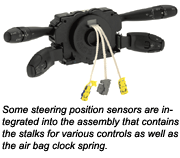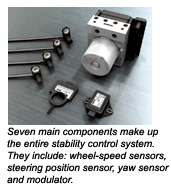The steering position sensor’s basic function is to monitor the driver’s steering inputs. This includes the angle of the steering wheel and/or the rate at which the driver is turning the wheel. The information may be used to vary hydraulic pressure in a variable-assist power steering system, or by a stability control system to improve handling, braking and traction under changing driving conditions.
EARLY APPLICATIONS
On early Ford systems, the steering sensor functioned only as a rotation sensor. It did not measure the angle of the steering wheel, but only the rate at which the steering wheel was being turned by the driver.
Most of these early generation steering sensors were optical sensors with photo diodes inside that read evenly spaced slits in a disc attached to the steering column. Turning the steering wheel to either side generated a pulse signal that went to a steering control module.
On the Ford VAPS system, the control module ignores the steering inputs as long as the driver is making relatively slow steering motions (less than 90 degrees of rotation per second). But if the driver turns sharply or swerves, the control module reacts by reducing current to the cutout solenoid to increase assist.
On later versions of the Ford VAPS system that appeared on the Ford Probe, the steering sensor also measured the actual angle of the steering wheel. At speeds below 6 mph or when the steering wheel was turned more than 45 degrees off-center, the VAPS system delivered full power assist. But at higher speeds or when the steering wheel was within 45 degrees of center, power assist was reduced.
In the event of a steering sensor failure, most the system was designed to fail-safe with full assist remaining on regardless of vehicle speed, angle or rate of rotation. Diagnostics on these early systems did not require a scan tool. On the Lincoln, the system could be diagnosed by plugging an analog voltmeter into the steering diagnostic connector located near the master brake cylinder. This put the system into a self-diagnostic mode that would cause the voltmeter needle to sweep back and forth to indicate fault codes. On the T-Bird and Cougar, a test light could be used for the same purpose, and to verify a signal from the steering angle sensor. Rotating the steering wheel at least 220 degrees in one direction would cause the light to come on for about three seconds. If the light did not come on, it meant there was a problem in the steering sensor or wiring.
If you find yourself troubleshooting one of these older systems, measuring the resistance between the sensor’s connector pins and comparing the values to specifications will tell you if the sensor is good or bad. On some applications, an analog ohmmeter can be used to detect pulses from the sensor as the steering wheel is rotated with the key on.
MORE SENSITIVE SENSORS
Most of the early steering position sensors are relatively low resolution sensors, and typically detect steering movements in 8 to 9 degrees increments. Most of today’s steering position sensors are high resolution magnetic sensors that can detect movements of one degree or less. Some have resolutions as low as one tenth of a degree! Steering angle sensors are used for a wider variety of purposes today, and for fast-acting stability control systems to react instantly to changing driving conditions, the system must be able to detect even small changes in the position.
Advances in onboard computing power in recent years and system integration and information sharing via local area networks (LAN) and controller area networks (CAN) now make it possible for various systems to share information and sensor inputs.
Consequently, the inputs from a steering position sensor can be used to vary power steering assist, to modify anti-lock braking and traction control, to assist stability control, to modify the reaction of an electronic suspension system, to modify torque delivery in an electronic all-wheel drive system, and to even monitor the driver himself.
The steering position sensor also will play a key role in future accident avoidance systems that detect obstacles and steer the vehicle to avoid the obstacle if the driver fails to react. The steering sensor also provides input for the new “parking assist” systems that are now starting to appear on certain luxury vehicles.
ELECTRONIC STABILITY CONTROL
Electronic stability control system are being added to more and more new vehicles. It is now found on 29 percent of all 2006 models, including 57 percent of all SUVs. Stability control requires monitoring the steering angle and driver’s steering inputs via a steering angle sensor on the steering column.
The steering angle sensor tells the ABS control module where the driver is steering the vehicle while the body motion sensors tell it how the body is responding. At the same time, the ABS wheel-speed sensors are monitoring tire traction and slippage on the road itself. The control module takes all of this information into account and compares the sensor inputs to its programming to determine overall vehicle dynamics.
DIAGNOSTICS
Diagnostics require the use of a scan tool on most vehicles, and the scan tool must have the appropriate software that can access the stability control/ABS system. If you find a steering position sensor code, you’ll have to follow the diagnostic charts to isolate the fault as the problem may be in the wiring or the sensor itself.
In magnetic sensors, there are no moving parts so the units are fairly reliable. Even so, faults may occur in the internal electronic circuitry that processes and generates the sensor’s output signal. Loss of voltage or ground can prevent the sensor from functioning properly, so wiring faults should be ruled out before replacing the sensor. The sensor itself is a sealed assembly and is not repairable or rebuildable.
Some steering sensors have their own built-in self-diagnostics and will generate a warning signal to the stability control system or body control module if it detects any internal faults. The stability control system or body control module may also set a fault code if the signal from the steering position sensor is lost or is out of range. The system may also compare the steering angle reading against the yaw sensor when the vehicle turns to see if the signals correspond. Depending on the vehicle application and scanner software, it may be possible to read the steering angle through the scan tool.
 STEERING SENSOR PRECAUTIONS
STEERING SENSOR PRECAUTIONS
Steering sensors are located in the steering column typically behind the turn signal assembly. The sensor may be integrated with the clockspring assembly for the air bag system, but it is usually a separate component. Access requires disabling the air bag system, removing the steering wheel and turn signal assembly. On some vehicles the steering sensor must be aligned or recalibrated if it is removed or replaced. On some vehicles, it requires the use of a scan tool.
On some of the older Mercedes applications, the steering angle sensor is initialized by turning the ignition to RUN, and rotating the steering wheel lock to lock.
On Cadillacs and other GM vehicles with Stabilitrak, some steering position sensors have alignment marks that must be aligned BEFORE the sensor is removed. The location of these marks will vary depending on the sensor, model year and vehicle. Some replacement sensors have a locator pin that is used for alignment. The details are covered in GM TSB 03-02-36-002.
 On 2004 Toyota RAV4, Tacoma and Tundra, and 2005 Scion xA models, the steering angle sensor initialization procedure goes as follows if the sensor has been removed or replaced. For more info, see Toyota TSB BR001-04”:
On 2004 Toyota RAV4, Tacoma and Tundra, and 2005 Scion xA models, the steering angle sensor initialization procedure goes as follows if the sensor has been removed or replaced. For more info, see Toyota TSB BR001-04”:
With the Toyota scan tool, you choose Diagnosis, the 1 – OBD/MOBD, then enter the model year and model. Then you scroll down to 4 – ABS/VSC, choose 6 – Reset Memory and press Yes. After the memory reset is completed, choose 7 – Signal Check. The VSC/TRAC and ABS should begin to flash at 0.13 second intervals. Then press Exit to quit signal check. If you don’t have Toyota scan tool, the following also works:
Put the transmission in Park, and turn the ignition ON.
Using a jumper wire, short terminals Ts and CG on the DLC3 diagnostic connector four times or more within eight seconds. This will erase the recorded zero point.
Turn the ignition to OFF and remove the jumper wire.
Make sure the steering wheel is centered, and turn the ignition switch back ON.
The stability control warning light will come on, then go off after about 15 seconds.
Wait at least two seconds after the light goes off, then turn the ignition back OFF.
Use the jumper wire to reconnect terminals Ts and CG on the DLC3 connector, and turn the ignition back ON.
The traction control warning light should come back on and start to flash after about four seconds. The zero point has been reset. The ignition switch can now be turned OFF and the jumper wire removed.
On Audi and Volkswagen models with electronic stability control, the G85 steering angle sensor requires a “zero position” calibration if the sensor is removed or replaced:
Start the vehicle and turn the steering wheel one turn to the right and one turn to the left.
than 20 km/h.
If the steering wheel is straight during the test drive, stop the vehicle with the wheels pointed straight ahead. Make sure the steering wheel does not move.
Keep the engine running. Do not switch off the ignition.
Using the VW scan tool, select mode 03 – ABS Brakes, then Login – 11, then Enter 40168, then Do It, then Basic Settings – 04, then Group 060, then Go. This will set the zero (centered) position of the steering sensor and display a message that reads: “Steer. angle sender compens OK.” If you get an error, it may mean the Login was not successfully performed.
Click Done/Go Back and you’re finished.












